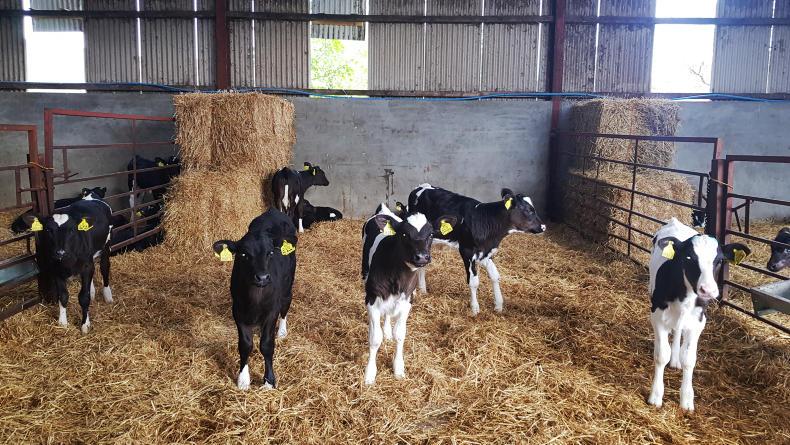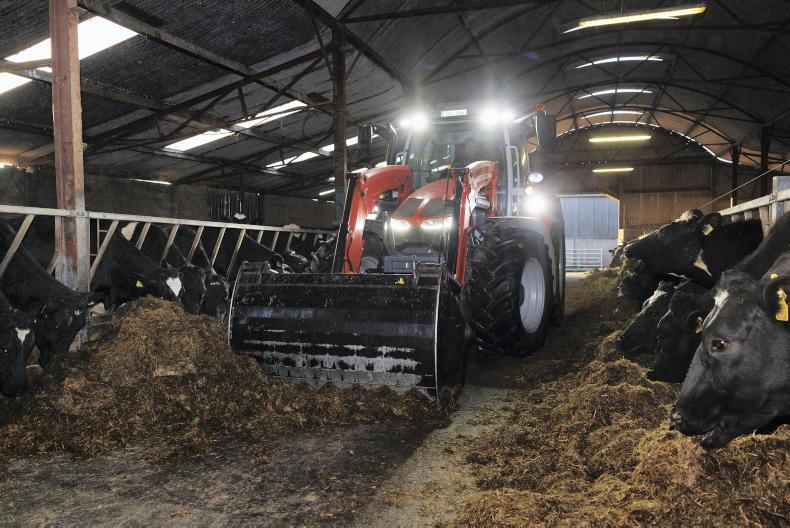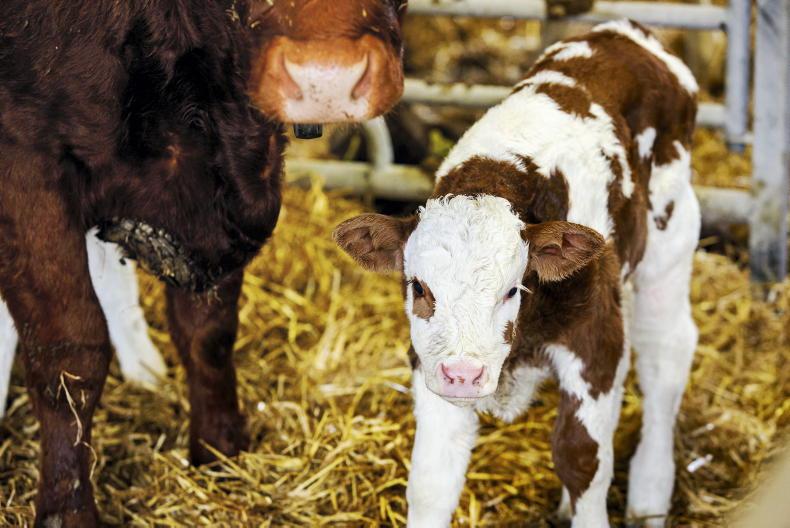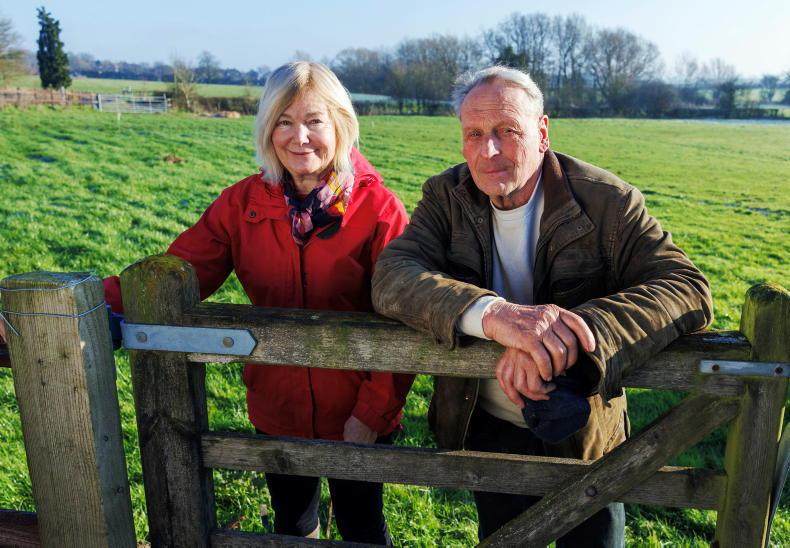John Oliver is almost three-quarters way through calving on his farm near Limavady, Co Derry. There are 78 early-lactation cows milking at present, with 26 dry cows and four heifers still to calve down.
Calving on the Oliver farm started in late August and cows are calving down in a fairly compact block. There will only be six cows due to calve in December, four in January and two in February.
John is considering selling off these later-calving cows as springers or fresh-calvers to help maintain the tight autumn-calving profile.
Overall, calving has been going well so far this year. Concentrates are fed in both in-parlour and out-of-parlour feeders in a feed-to-yield system, with cows wearing auto-ID collars.

Fresh calvers on the Oliver farm are averaging 28 litres/cow/day from 8.7kg/cow/day of concentrates.
At present, the fresh-calvers are averaging 28 litres/cow/day from 8.7kg/cow/day of an 18% crude protein dairy nut. There is no diet feeder on the farm and the current performance means cows are taking around maintenance plus 8.5 litres from silage.
John is using second-cut silage at present and he should be into first-cut around mid-December.
Feeders
With most of his cows at the same stage of lactation, John is able to set in-parlour feeders at a flat rate of 4kg/cow/day across the herd and then individual cows get topped up in out-of-parlour feeders.
Heifers are on a higher flat rate of 6kg/cow/day in the parlour to help keep intakes up while they get used to eating from the out-of-parlour feeders.
Cows are fed ahead of demand to push yields for the first 100 days in a ‘lead feed’ programme. Average concentrate feeding is likely to peak at around 10kg/cow/day and yields at over 30 litres/cow/day.
Farmers with a computerised program for feeding cows should check intakes regularly. John noticed on Monday that the feed rate for some cows wasn’t rising because the ‘maximum daily increase’ setting was sitting at zero by accident, instead of 0.5kg.
He is also keeping a close eye on cow body condition score during early lactation. Dairylink adviser Aidan Cushnahan is reminding programme farmers that condition score should not drop by more than 0.5 during early lactation and it should not be below a score of 2.0 by 60 days post-calving.
Ketosis
Dairylink farmers are testing early-lactation cows for sub-clinical ketosis. The metabolic disease can occur in early-lactation cows when fat is mobilised to meet the negative energy balance.
Ketosis happens when the liver cannot fully utilise this fat and by-products, known as ketones, overflow the blood. This results in reduced appetite and milk yields.
Aidan Cushnahan has equipped Dairylink participants with a ketosis testing kit
Similar to other health issues, such as milk fever, ketosis can occur sub-clinically, meaning the symptoms are not readily observable, but underlying issues can have an impact on appetite, yields and fertility.
Aidan Cushnahan has equipped Dairylink participants with a ketosis testing kit. It involves dipping a paper test strip into milk samples from individual cows and then comparing the colour change to a chart.
Anything below 100 micro mol/litre is not an issue. Over 100 is questionable and anything over 150 has issues
On Monday, John tested all cows that have calved within the past three weeks. The results were good and all cows recording a BHB (type of ketone) concentration of 50 micro mol/litre, except for one cow that had 100 micro mol/litre.
“Anything below 100 micro mol/litre is not an issue. Over 100 is questionable and anything over 150 has issues,” Aidan said.
If there are issues with ketosis in herds, additional supplementation with a high-energy feed during the late dry period and early lactation is generally recommended.
Weekly round-up
Calving continues on most Dairylink Ireland programme farms.The first autumn-born calves will begin to be weaned off milk this week.All autumn-calving Dairylink farms are testing freshly-calved cows for sub-clinical ketosis.Programme participants are finalising sire selection for breeding at the end of next month.Rearing calves during a busy time
The oldest calves are now two months old on the Oliver farm. A batch were weighed on Tuesday and averaged 83kg, which equates to a liveweight gain of 0.83kg/day from birth.
This group will start to be weaned over a two-week period, starting at the weekend. They should be around 100kg liveweight and consuming 2kg/head/day of meal by weaning.
John is using a whey-based milk replacer with 26% crude protein and 16% crude fat. The maximum feed rate is 850g/calf/day over two feeds.
With three-quarters of the herd calving in eight weeks, the autumn is a busy time for John
Calves are put in individual pens and fed colostrum for three days or until they are confident at sucking a teat. They are then moved into straw-bedded pens with a maximum of 10 calves per pen.
With three-quarters of the herd calving in eight weeks, the autumn is a busy time for John, so he has had to streamline his calf-rearing process to be more labour-efficient.
Calves have access to straw bales, which removes the need to fill racks in each pen.
These bales are eventually used for bedding, so less time is used up moving bales around the shed or yard during calving.
Water drinkers have also been installed in each pen and a passage runs along the top of each pen so that teat feeders can be moved without having to climb over any gates or step into pens.
Read more
Getting prepared for calving in Derry
Calf rearing lessons from the Netherlands
John Oliver is almost three-quarters way through calving on his farm near Limavady, Co Derry. There are 78 early-lactation cows milking at present, with 26 dry cows and four heifers still to calve down.
Calving on the Oliver farm started in late August and cows are calving down in a fairly compact block. There will only be six cows due to calve in December, four in January and two in February.
John is considering selling off these later-calving cows as springers or fresh-calvers to help maintain the tight autumn-calving profile.
Overall, calving has been going well so far this year. Concentrates are fed in both in-parlour and out-of-parlour feeders in a feed-to-yield system, with cows wearing auto-ID collars.

Fresh calvers on the Oliver farm are averaging 28 litres/cow/day from 8.7kg/cow/day of concentrates.
At present, the fresh-calvers are averaging 28 litres/cow/day from 8.7kg/cow/day of an 18% crude protein dairy nut. There is no diet feeder on the farm and the current performance means cows are taking around maintenance plus 8.5 litres from silage.
John is using second-cut silage at present and he should be into first-cut around mid-December.
Feeders
With most of his cows at the same stage of lactation, John is able to set in-parlour feeders at a flat rate of 4kg/cow/day across the herd and then individual cows get topped up in out-of-parlour feeders.
Heifers are on a higher flat rate of 6kg/cow/day in the parlour to help keep intakes up while they get used to eating from the out-of-parlour feeders.
Cows are fed ahead of demand to push yields for the first 100 days in a ‘lead feed’ programme. Average concentrate feeding is likely to peak at around 10kg/cow/day and yields at over 30 litres/cow/day.
Farmers with a computerised program for feeding cows should check intakes regularly. John noticed on Monday that the feed rate for some cows wasn’t rising because the ‘maximum daily increase’ setting was sitting at zero by accident, instead of 0.5kg.
He is also keeping a close eye on cow body condition score during early lactation. Dairylink adviser Aidan Cushnahan is reminding programme farmers that condition score should not drop by more than 0.5 during early lactation and it should not be below a score of 2.0 by 60 days post-calving.
Ketosis
Dairylink farmers are testing early-lactation cows for sub-clinical ketosis. The metabolic disease can occur in early-lactation cows when fat is mobilised to meet the negative energy balance.
Ketosis happens when the liver cannot fully utilise this fat and by-products, known as ketones, overflow the blood. This results in reduced appetite and milk yields.
Aidan Cushnahan has equipped Dairylink participants with a ketosis testing kit
Similar to other health issues, such as milk fever, ketosis can occur sub-clinically, meaning the symptoms are not readily observable, but underlying issues can have an impact on appetite, yields and fertility.
Aidan Cushnahan has equipped Dairylink participants with a ketosis testing kit. It involves dipping a paper test strip into milk samples from individual cows and then comparing the colour change to a chart.
Anything below 100 micro mol/litre is not an issue. Over 100 is questionable and anything over 150 has issues
On Monday, John tested all cows that have calved within the past three weeks. The results were good and all cows recording a BHB (type of ketone) concentration of 50 micro mol/litre, except for one cow that had 100 micro mol/litre.
“Anything below 100 micro mol/litre is not an issue. Over 100 is questionable and anything over 150 has issues,” Aidan said.
If there are issues with ketosis in herds, additional supplementation with a high-energy feed during the late dry period and early lactation is generally recommended.
Weekly round-up
Calving continues on most Dairylink Ireland programme farms.The first autumn-born calves will begin to be weaned off milk this week.All autumn-calving Dairylink farms are testing freshly-calved cows for sub-clinical ketosis.Programme participants are finalising sire selection for breeding at the end of next month.Rearing calves during a busy time
The oldest calves are now two months old on the Oliver farm. A batch were weighed on Tuesday and averaged 83kg, which equates to a liveweight gain of 0.83kg/day from birth.
This group will start to be weaned over a two-week period, starting at the weekend. They should be around 100kg liveweight and consuming 2kg/head/day of meal by weaning.
John is using a whey-based milk replacer with 26% crude protein and 16% crude fat. The maximum feed rate is 850g/calf/day over two feeds.
With three-quarters of the herd calving in eight weeks, the autumn is a busy time for John
Calves are put in individual pens and fed colostrum for three days or until they are confident at sucking a teat. They are then moved into straw-bedded pens with a maximum of 10 calves per pen.
With three-quarters of the herd calving in eight weeks, the autumn is a busy time for John, so he has had to streamline his calf-rearing process to be more labour-efficient.
Calves have access to straw bales, which removes the need to fill racks in each pen.
These bales are eventually used for bedding, so less time is used up moving bales around the shed or yard during calving.
Water drinkers have also been installed in each pen and a passage runs along the top of each pen so that teat feeders can be moved without having to climb over any gates or step into pens.
Read more
Getting prepared for calving in Derry
Calf rearing lessons from the Netherlands










SHARING OPTIONS